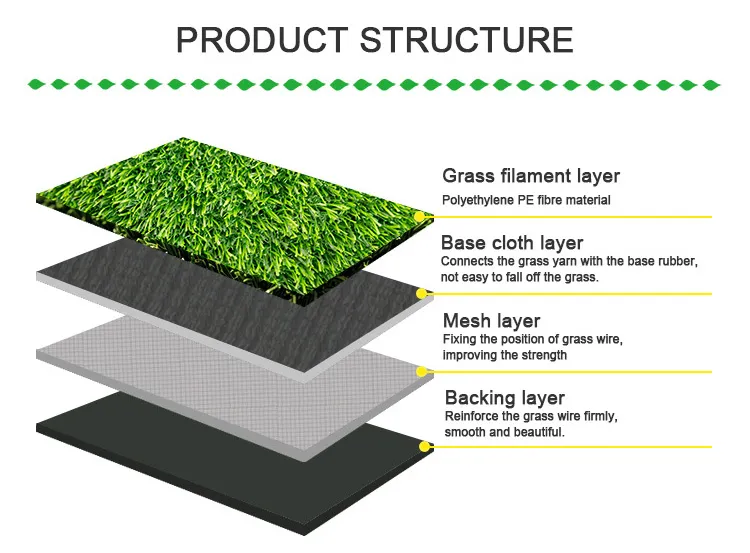
- Afrikaans
- Arabic
- Belarusian
- Bengali
- Czech
- Danish
- Dutch
- English
- Esperanto
- Estonian
- Finnish
- French
- German
- Greek
- Hindi
- Hungarian
- Icelandic
- Indonesian
- irish
- Italian
- Japanese
- kazakh
- Rwandese
- Korean
- Kyrgyz
- Lao
- Latin
- Latvian
- Malay
- Mongolian
- Myanmar
- Norwegian
- Persian
- Polish
- Portuguese
- Romanian
- Russian
- Serbian
- Spanish
- Swedish
- Tagalog
- Tajik
- Thai
- Turkish
- Turkmen
- Ukrainian
- Urdu
- Uighur
- Uzbek
- Vietnamese
artificial grass sports
Nov . 16, 2024 17:08 Back to list
The Rise of Artificial Grass in Sports A Game Changer
In recent years, artificial grass has emerged as a revolutionary element in the world of sports. This synthetic turf, designed to mimic the appearance and feel of natural grass, has gained immense popularity in various athletic disciplines, ranging from football and soccer to tennis and golf. The transition to artificial grass is not merely a trend; it represents a significant transformation in how sports are played, maintained, and enjoyed.
Benefits of Artificial Grass
One of the key advantages of artificial grass is its durability. Natural grass can be a challenge to maintain, requiring regular watering, mowing, and fertilization. Weather conditions can also significantly affect the quality of natural playing fields. In contrast, artificial grass is designed to withstand various weather conditions, providing a consistent playing surface regardless of rain or shine. This reliability means that athletes can train and compete on a predictable surface, reducing the risk of injuries caused by uneven or muddy grounds.
Another major benefit is the reduction in maintenance costs. Facilities equipped with artificial grass can save substantial amounts on water, fertilizers, and labor required for upkeep. This cost efficiency becomes particularly important in urban areas where water scarcity is a growing concern. Moreover, artificial sports fields can be used more intensively without suffering the damage that natural grass fields might incur after too much use. This allows for increased community engagement, as more teams and events can utilize the same facility without compromising quality.
Performance Enhancements
Athletes and coaches have noted the performance enhancements that artificial grass provides. For sports like soccer and football, synthetic turf offers a consistent playing surface that enables better ball control and predictable bounces. The pace of play can also be accelerated on artificial turf, leading to a more dynamic and exciting game. The improved traction reduces the chance of slipping, allowing players to perform at their best without the fear of losing their footing.
Moreover, advancements in technology have led to the development of artificial grasses that better simulate the feel of natural grass, providing players with a more enjoyable and authentic experience. These newer generations of artificial turf incorporate a variety of fibers and infill materials designed to enhance the look and feel, making them increasingly indistinguishable from their natural counterparts.
artificial grass sports

Environmental Considerations
Despite some criticisms regarding environmental impacts, the modern production of artificial grass has embraced sustainability. Many turf products today are manufactured using recycled materials, and at the end of their lifespan, they can also be recycled into new products. Furthermore, the reduced need for water and chemicals on artificial fields contributes positively to environmental conservation efforts, aligning with global sustainability goals.
While some argue that artificial grass can contribute to higher surface temperatures, sports organizations are actively involved in addressing these concerns. Innovative cooling technologies are being explored, alongside the strategic placement of shade structures to protect athletes from extreme heat during play.
Challenges and Future Trajectory
Despite its advantages, the adoption of artificial grass is not without its challenges. Concerns about safety, particularly regarding the materials used in its construction, have been raised over the years. Proponents emphasize that high-quality turf products meet strict health and safety regulations, ensuring they are safe for athletes of all ages.
Looking ahead, the future of artificial grass in sports appears bright. As technology progresses, we can anticipate even more sophisticated materials that will enhance player performance, safety, and environmental sustainability. The integration of smart technology, such as sensors embedded within the turf to monitor usage and maintenance needs, could further revolutionize how sports facilities operate.
In conclusion, the rise of artificial grass in sports signifies more than just a shift from natural to synthetic fields; it reflects a broader change in how communities, athletes, and organizations approach sports management and sustainability. With its myriad of advantages, artificial grass is undoubtedly a game changer, promising a future where sports can thrive in a more efficient, enjoyable, and sustainable environment.
-
The Benefits of Artificial Turf for Indoors
NewsJul.15,2025
-
How Artificial Grass Suppliers Ensure Quality Products
NewsJul.15,2025
-
Artificial Grass and Pets: A Space for Relaxation
NewsJul.08,2025
-
Balcony & Outdoor Decoration with Artificial Grass
NewsJul.08,2025
-
Best Indoor Artificial Grass for Home
NewsJul.07,2025
-
Best Pet Turf for Dogs: Safe & Durable Artificial Grass Options
NewsJul.07,2025
Products categories









